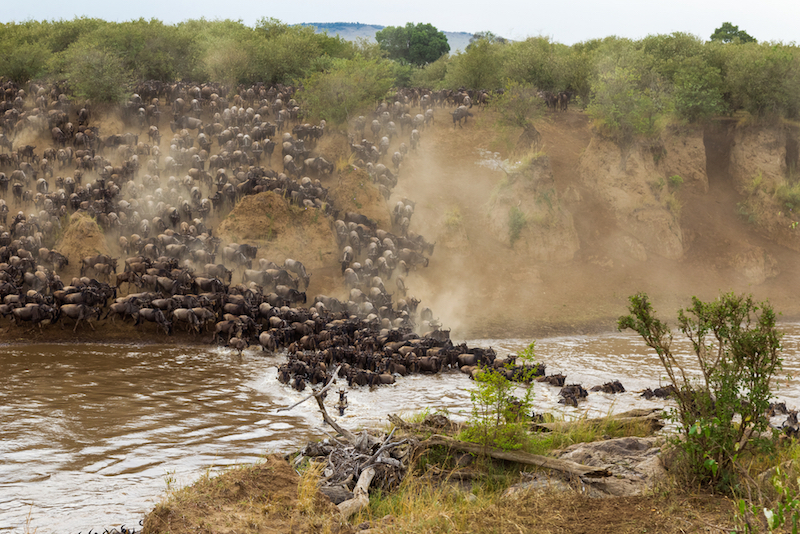Thousands of Decaying Wildebeest Corpses Keep Serengeti Well Fed

Every year, thousands of wildebeests tumultuously drown while trying to cross the Mara River in eastern Africa, but there is a silver lining to their deaths: The wildebeest remains provide essential nutrients to wild animals throughout the Serengeti food web, according to a new study.
About 1.2 million wildebeests, also known as gnus (Connochaetes taurinus), take part in the largest terrestrial migration in the world, traveling from the dry plains to the lush savanna in search of food and water every year, the researchers said.
But an average of 6,250 wildebeests — or 1,100 tons (1,000 metric tons) of biomass — never make it across the Mara. Rather, their bodies decompose, contributing the "equivalent biomass of 10 blue whale carcasses per year to this moderately sized river," the researchers wrote in the study. [Camera Trapped: Elusive Wildlife Caught in Photos]
There were at least 13 mass drownings between 2001 and 2015, according to historical reports and field surveys, the researchers said. These mass drownings typically happen from early June to late July, when the wildebeests make their annual migration across the Mara, a river that pours into Lake Victoria and provides water for the greater Serengeti Mara ecosystem of Kenya and Tanzania.
Once the wildebeests meet their untimely ends, it isn't long before scavengers — including vultures, some flying more than 60 miles (100 kilometers) to dine — show up with hearty appetites. These scroungers include Nile crocodiles, Marabou storks, white-backed vultures, Rüppell's vultures and hooded vultures, the researchers said.
The scavengers aren't the only beneficiaries: The wildebeests' soft tissues take between two and 10 weeks to decompose, and then provide as much as 50 percent of the food that supports fish populations in the Mara, the researchers found. Moreover, maggots — a favorite meal of the mongoose — flourish on the wildebeests' dead bodies, the researchers noted.
The wildebeests' bones take more than seven years to decompose, providing much-needed phosphorus to the river, which, in turn, supports algae, insects and fish, the researchers said.
Sign up for the Live Science daily newsletter now
Get the world’s most fascinating discoveries delivered straight to your inbox.
"Rotting animal flesh spikes the aquatic ecosystem with nutrients," study co-researcher Emma Rosi, an aquatic ecologist at the Cary Institute of Ecosystem Studies in Millbrook, New York, an environmental research organization, said in a statement."But once carcasses disappear, bones — which make up nearly half of biomass inputs — continue to feed the river."
Moreover, these nutrients travel throughout the river basin, as they are either carried downstream by the river or taken inland by scavengers, the researchers found.
"The frequency and scale of these events suggest that mass drownings may have played an important role in other rivers historically, when large migrations and unimpacted rivers were more common features of the landscape," lead researcher Amanda Subalusky, a postdoctoral associate at the Cary Institute, said in a statement.
Subalusky worked on the study as a graduate student in the Department of Ecology and Evolutionary Biology at Yale University. The research was published online June 19 in the journal Proceedings of the National Academy of Sciences.
Original article on Live Science.

Laura is the archaeology and Life's Little Mysteries editor at Live Science. She also reports on general science, including paleontology. Her work has appeared in The New York Times, Scholastic, Popular Science and Spectrum, a site on autism research. She has won multiple awards from the Society of Professional Journalists and the Washington Newspaper Publishers Association for her reporting at a weekly newspaper near Seattle. Laura holds a bachelor's degree in English literature and psychology from Washington University in St. Louis and a master's degree in science writing from NYU.









